commentary Commentary
Commentary: Why Singapore's private residential market will remain attractive in the long term
Historical data shows Singapore private residential property typically sees a quick rebound after each economic crisis, says OrangeTee & Tie’s Christine Sun.
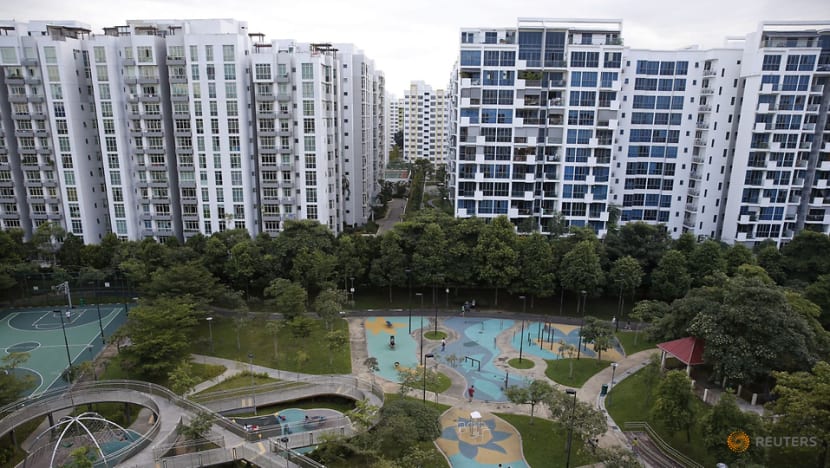
A view of private residential homes and executive condominiums in Singapore. (File photo: Reuters)
SINGAPORE: The impact of the coronavirus pandemic has rippled across the globe and disrupted most forms of business activity. Quarantines and movement restrictions imposed in many countries have halted trade, tourism and retail.
Real estate hasn’t been spared either. Singapore’s implementation of circuit breaker measures in April has impacted the private residential property market, as show flats shuttered and house viewings were discontinued.
Strict safe distancing measures have also disrupted the home purchase process for potential buyers, who have to rely on virtual house tours to assess properties.
According to data from the Urban Redevelopment Authority (URA), the overall price index of private homes slipped 1.0 per cent quarter-on-quarter in the first quarter of 2020, after rising for three consecutive quarters.
LISTEN: COVID-19 and the outlook for Singapore’s residential property market in 2020 and beyond
READ: Singapore new private home sales plunge 12% in the first quarter as prices dip
But this decline is still not as severe compared to initial price falls observed in past crises.
A first quarterly price decline of 1.9 per cent was recorded in 1996 at the start of the Asian financial crisis, while the global financial crisis saw an initial drop of 2.4 per cent in the third quarter of 2008.
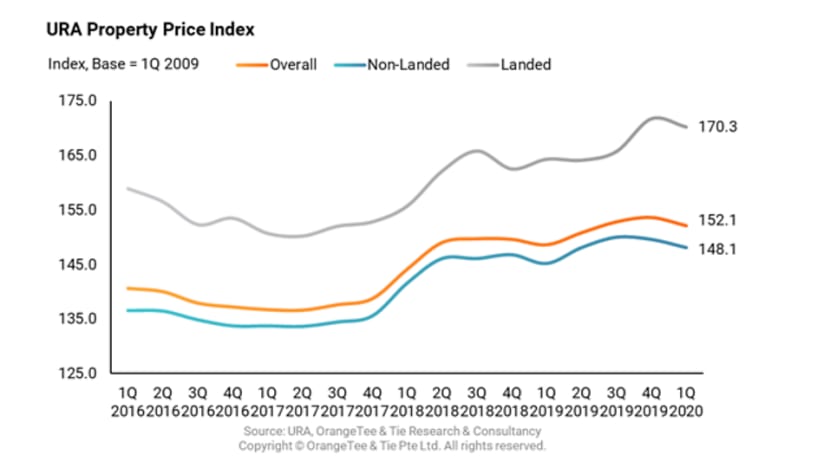
How much prices will decline further will depend on the duration of the pandemic. Other factors include the unemployment rate and financial health of home owners.
As of now, we have not seen significant numbers of homeowners defaulting on mortgages, likely because of several past cooling measures such as the TDSR (Total Debt Servicing Ratio) and Mortgage Servicing Ratio (MSR). These instil financial prudence in buyers by capping a borrower’s gross monthly income used to service their housing loans.
These limits will also not apply to the principal and interest for deferred payments on mortgages, as part of the Singapore Government’s package to aid homeowners during this challenging period.
READ: S$33b Fortitude Budget aimed at providing jobs, supporting workers and firms through 'difficult period' of COVID-19
LISTEN: How Singapore businesses and workers can thrive in a post-pandemic new normal
THE RECOVERY IN THE RENTAL MARKET
Investors should take a long-term view in any property investment. Singapore will continue to be a top investment destination and a safe haven for investors.
Despite the current economic slowdown, basic fundamentals that have attracted foreign investors all these years – such as the ease of doing business, transparency, safety and political stability – will likely remain unchanged.
A silver lining in the COVID-19 cloud lies in Singapore’s track record, where the private property market regularly recovers after every economic crisis.
Private properties have generally yielded positive capital appreciation over the past 30 years. Based on URA’s price index, prices of properties have risen across all market segments and weathered through some of the toughest crises including SARS, the Asian financial crisis and the global financial crisis.
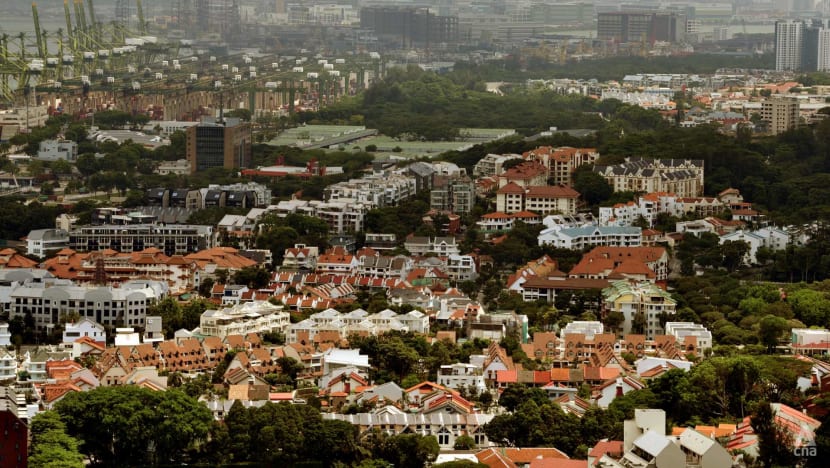
For those who intend to buy properties for rental income, the leasing market has remained strong.
After years of being in the doldrums, the rental market staged a remarkable performance in 2019 with higher transaction volume and occupancy rates amid a tightening of new inventory supply and depleting stock. The number of transactions rose 4.5 per cent to 93,960 units in 2019 from 89,904 units in 2018, reaching an 11-year high.
READ: Commentary: COVID-19 will reshape the Singapore office property market outlook
Despite the pandemic, rental demand remains strong, with more leasing transactions and rental renewals recorded last quarter.
Resale volumes increased by 2.4 per cent from 20,703 units in the fourth quarter of 2019 to 21,191 units in the first quarter of 2020.
Rents rose across all market segments, as the overall rental index increased 1.1 per cent quarter-on-quarter and 1.4 per cent year-on-year in the first quarter of this year, possibly because many tenants were reluctant to scout around for alternate housing. Some required immediate lodging to serve stay-home notices after returning from overseas.
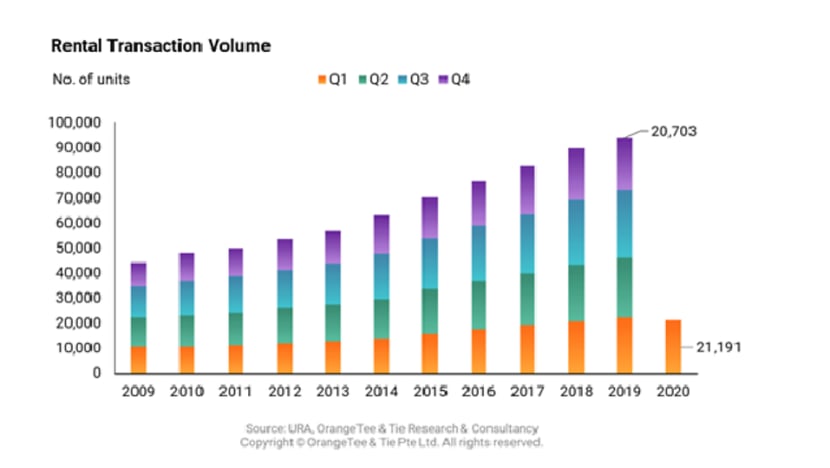
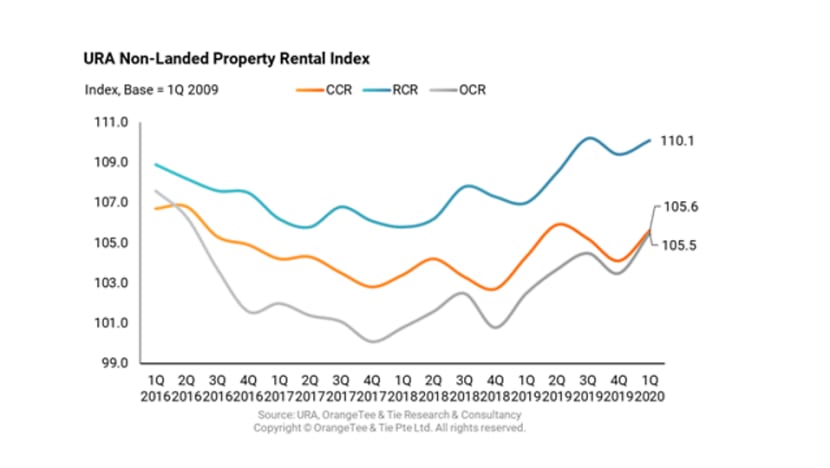
MORE BUYERS ARE ENTERING A MARKET
We have seen signs of investors streaming into the market to pick up some value buys. The number of luxury home sales in the Core Central Region (CCR) have been rising over the past few months.
The number of non-landed transactions rose from 666 units in the third quarter of 2019, to 951 units in the fourth quarter and 1,032 units in the first quarter of 2020.
READ: Commentary: Did aggressive land bidding by Chinese developers push up Singapore property prices?
In April, slightly more than a third (36.8 per cent of 277 units) or 102 new home sales were from the Core Central Region.
The highest priced private home transacted was a super-luxury condominium (477 sqm) at 15 Holland Hill for S$13.8 million or $2,692 per square foot in April. This is the third priciest new condominium unit transacted over the past 12 months.
Well-located private homes with attractive pricing also continue to draw buying interest. Properties like Treasure at Tampines, Jadescape, Parc Esta, Stirling Residences, Parc Clematis and Kopar at Newton continue to see steady sales over the past few weeks before the circuit breaker. Many are located near amenities, MRT stations or near the downtown core.
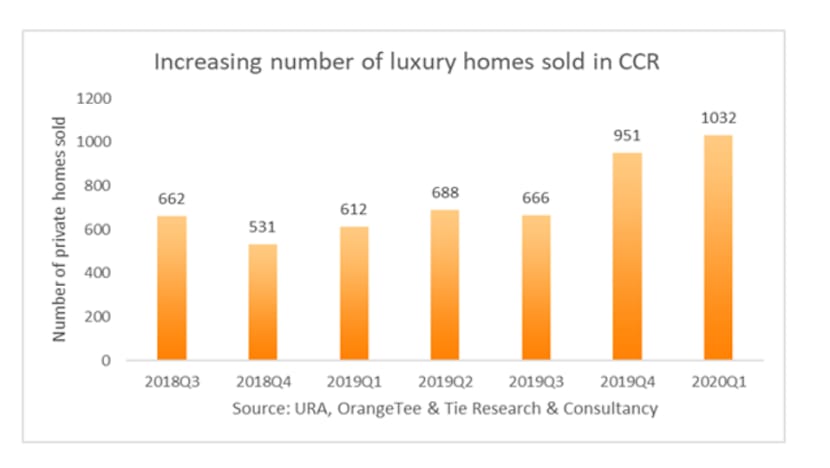
Historical data on private property housing has shown that while sales volume and prices usually dip during a crisis, sales demand typically recovers shortly after.
As sales volume tends to rebound within three to four quarters, the window of opportunity for buying a property during a price correction is quite small.
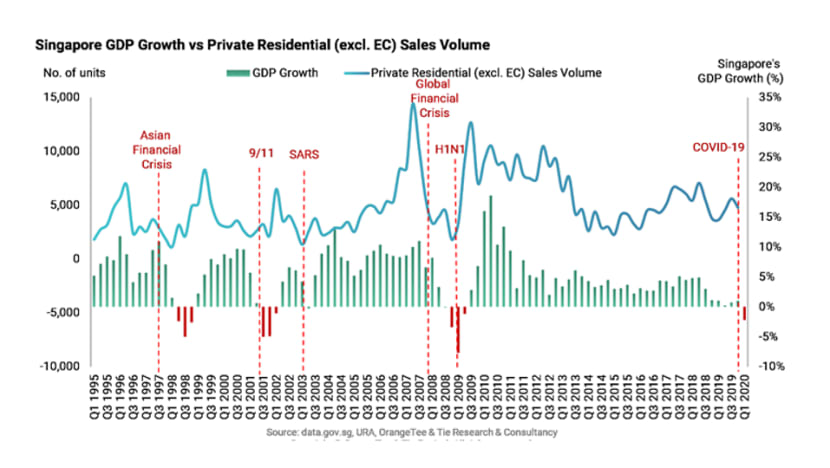
READ: In the 2020s, will property still be a safe bet for investors? Perhaps not
Our study analysing the profitability of private property over the years also reveals that many who bought new private homes during a downturn and resold them subsequently have made attractive profits. On average, home buyers during the financial crisis in 2008 made the highest gross profits over the last 17 years compared to other buyers who bought properties during other periods of time.
For instance, buyers who bought a mass market home – that is, a non-landed private home – in the Outside of Central Region or suburban areas made an average gross profit of about S$300,000 in the first quarter of 2009, compared to $50,000 to $200,000 for the average buyer outside this time period.
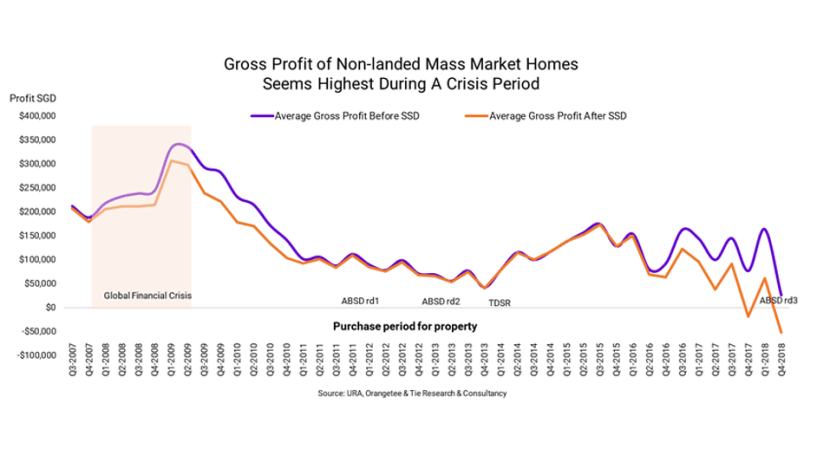
We expect to see a decline in the supply of private homes after 2023 for three reasons.
First, collective sales have slowed since cooling measures were slapped in 2018.
Second, most of the projected mega developments above 1,000 units, such as Treasure at Tampines, Jadescape, Parc Clematis, Parc Esta, Riverfront Residences, Stirling Residences, The Florence Residences and Affinity at Serangoon, have already been launched.
Third, many launched projects have sold more than 30 to 50 per cent of their entire project.
READ: 10 noob questions about buying your first property, answered
We expect developers to continue to pare down outstanding stock and take a measured approach to land acquisition in this coronavirus climate.
The number of new project launches will decline after 2020 as the last collective sales cycle has ended in 2018 while government land sales have generally been on the decline for the last eight years.
As fewer private homes are slated for completion after 2023, we predict that prices and rents of private homes will likely remain strong in the long term.
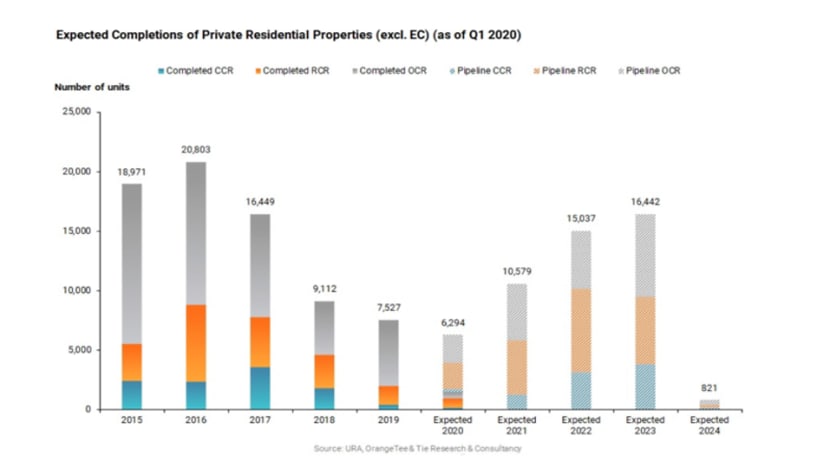
THE MARKET OUTLOOK
Many economists have differing views of the global economic outlook though there is a growing consensus of a protracted slowdown, with recovery gradual in the months ahead.
For the real estate market in Singapore, however, buying activities may rebound in some locations when circuit breaker measures ease, given pent-up demand.
After travel restrictions are lifted, some foreign buyers may return.
READ: Commentary: Why property prices remain high in Hong Kong despite protests and violence
Over the last past two years, Chinese buyers have formed the biggest foreign buyer group with 2,637 or 7.3 per cent non-landed private home purchases, followed by Malaysians at 4.3 per cent, Indians at 1.9 per cent and Indonesians at 1.6 per cent.
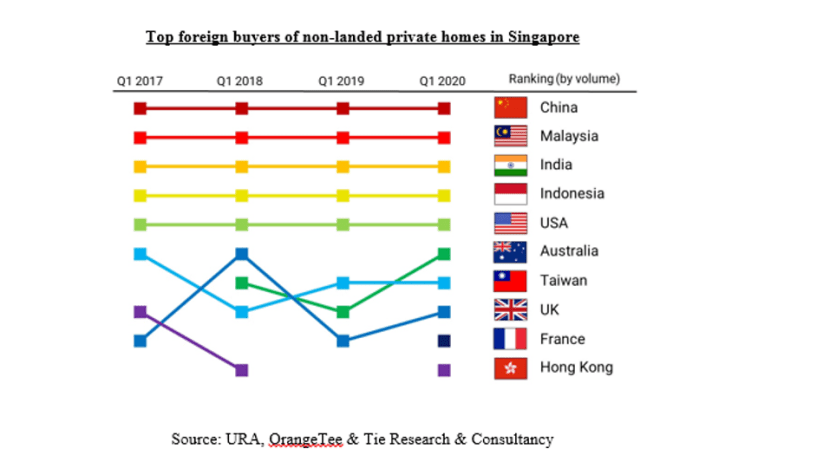
Mainland Chinese buyers may continue to be the biggest group. While China’s economy will experience a slowdown this year, this country will likely see pockets of growth across specific sectors, especially IT, biomedicine and healthcare.
The recent global lockdowns have also seen an exponential increase in production and consumption of e-commerce goods, with China being the powerhouse in this space.
For these reasons, we expect Chinese buyers from thriving sectors to buy homes here. Some may also divert their funds overseas as their currency continues to depreciate.
READ: Commentary: Embattled China knows its national priority is the economy
Notwithstanding the positive long-term outlook for the Singapore private residential market, the year will likely see some weakness in prices and home demand as a result of circuit breaker measures and global economic uncertainties.
Private home prices may fall up to 5 per cent if the pandemic drags on. We project sales of around 13,000 to 14,000 private homes this year, of which 6,500 to 7,500 are new home sales.
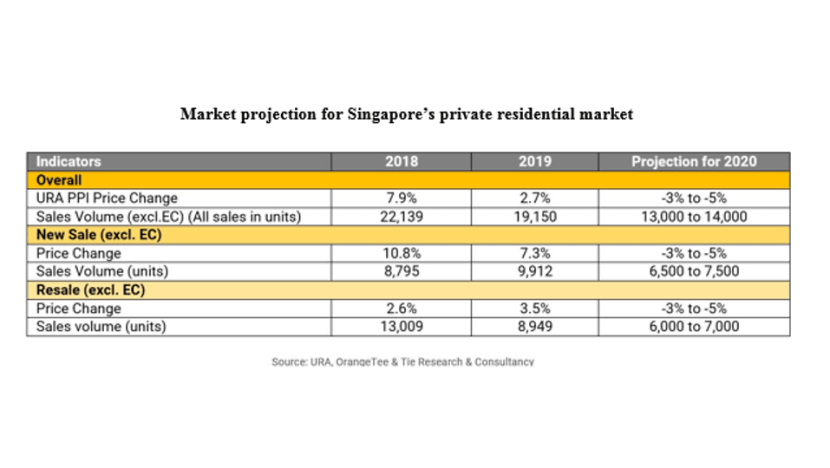
Christine Sun is Head of Research & Consultancy at OrangeTee & Tie.












